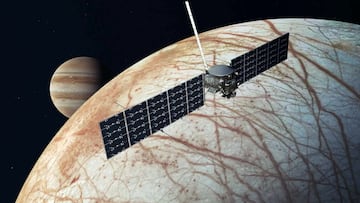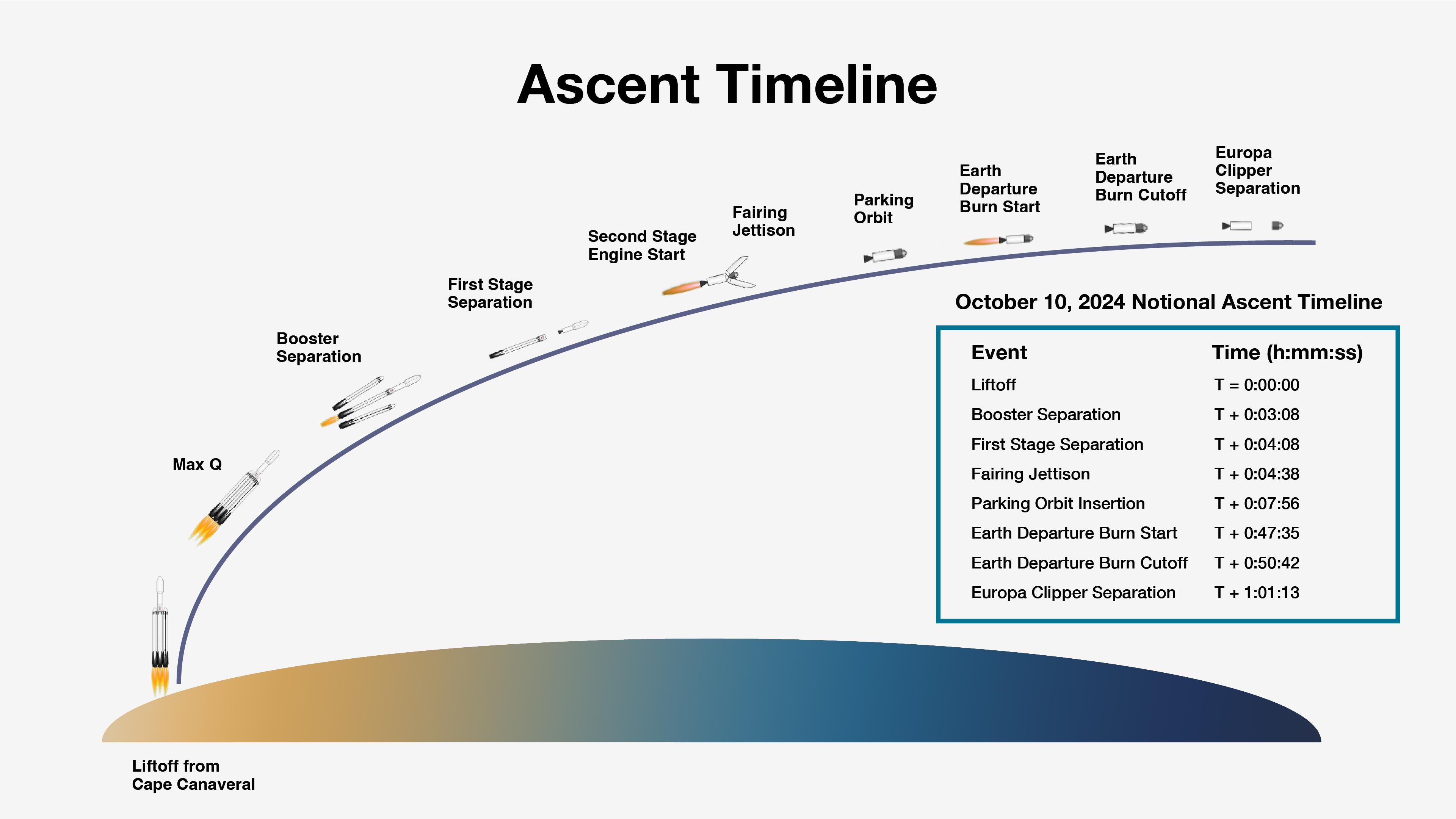NASA Europa Clipper mission live updates: latest news for the launch to Jupiter’s icy moon
Europa may be the only other place in the Solar System that has life. Follow the launch of NASA’s Europa Clipper mission to Jupiter’s strange moon.


Show key events only
NASA Europa Clipper launch: as it happened
Thanks for following!
Thank you for following the launch of the NASA Europa Clipper mission to Jupiter's fascinating moon.
Joe
Telemetry launched!
All the steps are online and active: the propulsion system is active, as is the solar-power.
Signal received from Europa Clipper!
The craft is active and has sent a message back to Earth. Off it goes!
CLIPPER HAS SEPARATED
The craft has just separated from the rocket at T+1:03:33.
AOS, acquisition of signal, is the next step. This can take anywhere from a few seconds up to a few minutes. The message is effectively the the handshake from Europa Clipper to the crew.
What happens next?
The craft will extend its huge, basketball court-sized solar panels over the next few hours, and it'll be a few months before Europa Clipper reaches Mars for a gravity assist.
The first rocket separations have concluded:
We've now got to go through the various stages of separation as the rocket flies around Earth. Checks are also being made to ensure communications with the craft are OK as the journey continues into deep space.
3, 2, 1...
LIFT OFF!
Falcon Heavy lifts off from Earth on its search for life on Jupiter's Icy moon of Europa.
"GO FOR LAUNCH"
The flight commander has issued the all-important message.
90 seconds until lift-off...
All things seem in order ahead of lift-off of the Europa Clipper mission.
The temperature issue has been resolved and the flight computer has taken over.
"NASA team is go for launch, pending the anomaly"
The message has just come through the NASA radio... the temperature levels in the second stage are being monitored, but there shouldn't be a problem.
Smoke is coming out of the rocket as the clock counts down
It's quite a scene and things look good as we move into the five-minute mark ahead of launch...
Europa fact-file:
· It is one of the 4 largest moons that Jupiter has (from a total of 95)
· The icy crust is thought to be 10-15 miles thick
· Europa is 6 times brighter than our own moon
· It takes just 3.5 days for Europa to orbit Jupiter (that's fast!)
TEN MINUTES TO GO
There are just 10 minutes to go until the launch of Europa Clipper!

NASAJPL-Caltech
Europa Clipper timeline:
Ignore the dates and times, they've been changed thanks to Hurricane Milton.
But the graphic is interesting: it's what will happen to the spacecraft in the various stages of the journey.
Ada Limón's poem, 'In Praise of Mystery: A Poem for Europa'
Arching under the night sky inky with black expansiveness, we point to the planets we know, we pin quick wishes on stars.
From earth, we read the sky as if it is an unerring book of the universe, expert and evident.
Still, there are mysteries below our sky: the whale song, the songbird singing its call in the bough of a wind-shaken tree.
We are creatures of constant awe, curious at beauty, at leaf and blossom, at grief and pleasure, sun and shadow. And it is not darkness that unites us, not the cold distance of space, but the offering of water, each drop of rain, each rivulet, each pulse, each vein.
O second moon, we, too, are made of water, of vast and beckoning seas. We, too, are made of wonders, of great and ordinary loves, of small invisible worlds, of a need to call out through the dark.
Why does the mission take over 5 years?
Simply put: the journey is long and Jupiter is far away.
To combat this, NASA have organised two 'gravity assists', one with Earth and the other with Mars.
A gravity assist is where a spacecraft is flown close to a planet to use the gravitational pull to its advantage, whizzing behind the planet and shooting off in the other direction.
It's a bit like a skateboarder gaining momentum by going round the park on their way to getting a run up towards a big ramp.
How fast will the rocket travel?
Since there is no air resistance in space, that means with the same amount of fuel you can reach speeds much greater than those on Earth.
As such, the rocket will travel through space at speeds ofanywhere from 10,000 - 100,000 mph, depending on its location in the Solar System.
We've got less than half an hour to go before NASA sends their largest probe ever to investigate a planetary body.
Greg has written a superb round-up of all the info you need regarding the mission to the icy moon.
Could there be life on Europa?
NASA believe that deep down in Europa, in the rocky third layer, which acts as the 'sea floor' of the moon, is the reason why life may exist.
The icy crust at the top of the planet seals the planet-wide ocean from sunlight, meaning that the energy to create any potential life must come from another source.
As such, they believe that Jupiter's pull keeps the sea floor moving and this could cause things such as sea vents to create conditions for life.
Will we know the results during the mission?
Yes. Europa Clipper's huge silver antennae sticking out of the top does more or less the same thing as your car aerial: it sends information a long way away.
The information will be sent at lightspeed back to Earth once Europa Clipper has moved out of the horrible radiation storm from Jupiter.
That message will take 45 minutes, despite the information travelling at 300,000 kilometres per second (186,000 miles per second).
And you complain about Earth rain...
A lot of testing went into the materials to make sure the craft could be shielded from the radiation that is fired towards it.
Electronics are inside vaults and cables are all wrapped with copper foil in order to fend off the constant rain-showers of radioactive particles Jupiter spits out on a daily basis.
T-minus...
45 minutes to go until launch!
What's the weather like?
Pretty much perfect: it's 80º and 7mph winds that are so high up in the sky there's no worry from anyone at NASA as to what effect they might have.
NASA are so happy they actually called the weather 'super-duper' on their official walkie-talkie radio channel. Really, they did.
How much water is on Europa?
According to NASA, Europa could well have DOUBLE the amount of water as we have on Earth.
The humungous gravitational pull of Jupiter keeps the moon in constant movement, a bit like an angry massage that compresses and stretches the sphere.
This keeps the water moving in tidal formations, increasing the movement of particles and a higher likelihood of, well, things happening under the surface.
The radiation emitted from the stormy gas planet also keeps mega waves of energy thumping at the surface of Europa, which ends up becoming a punch bag for all sorts of particles.
More about the mission...
Around one thousand people are working on Europa Clipper, with scientists collaborating from all over the U.S. and Europe. In total, over 4,000 people have helped NASA get to this moment since 2015.
As well as the scientists, NASA launched a campaign called “Message in a Bottle". The spacecraft is carrying a poem by U.S. Poet Laureate Ada Limón, cosigned by millions of people from nearly every country in the world.
The names have been stencilled onto a microchip attached to a metal plate that seals the spacecraft’s electronics vault. The plate also features waveforms of people saying the word “water” in over 100 spoken languages.
More about the spacecraft:
Europa Clipper is a solar-powered robotic spacecraft that will orbit Jupiter and aim to determine if there are subsurface environments capable of supporting life.
When fully deployed, the spacecraft spans over 100 feet (around 30 meters), roughly the size of a basketball court.
At launch, Europa Clipper will weigh about 13,000 pounds (6,000 kilograms), nearly half of which is fuel—approximately 6,000 pounds (2,750 kilograms) of propellant.
The spacecraft will use gravity assists from Mars and Earth to gain the speed necessary for reaching Jupiter by 2030.
Once in orbit around Jupiter, Europa Clipper will spend about a year adjusting its course for its first Europa flyby. Over the following three years, it will conduct dozens of flybys, gathering and transmitting data back to Earth to investigate nearly all of Europa’s surface.
What rocket will be used for the Europa Clipper mission?
The spacecraft used for the task is the largest NASA has ever built for a planetary mission.
The probe will launch on a SpaceX Falcon Heavy rocket from Launch Complex 39A at NASA’s Kennedy Space Center in Florida.
How long will the mission take?
The Europa Clipper spacecraft will travel 1.8 billion miles (2.9 billion km) to get to Jupiter and it will have reached its destination by in April 2030.
The craft will orbit Jupiter, and conduct 49 close flybys of Europa, where it will hopefully take some fantastically mind-bending photos of the strange world.
Why are NASA going to Europa?
Europa Clipper is the first mission designed to conduct a detailed study of Jupiter's moon Europa.
NASA say that "there’s scientific evidence that the ingredients for life may exist on Europa right now".
I'll explain: underneath its icy surface is a planet-wide sea of water: any location on Earth that has water also has life. If we put those two facts together, Europa quickly becomes a hugely enticing place to visit - and that is exactly what NASA intend to do, starting today.
The three things Europa Clipper aims to do are:
1. Determine the thickness of the moon’s icy shell and its interactions with the ocean below
2. Investigate what the moon is actually made of
3. Characterise the geology of the moon
Welcome!
Greetings Earthlings and welcome to the AS USA live feed of the NASA launch of their Europa Clipper mission to Europa, Jupiter's icy moon that some people think may have life.
We have the official NASA live video feed at the top and some important information for you below that if you want to know more about the launch, and stay tuned for any live updates as they happen.
NASA say that Europa Clipper’s launch is targeted for 12:06 p.m. EDT (1606 UTC).

Complete your personal details to comment